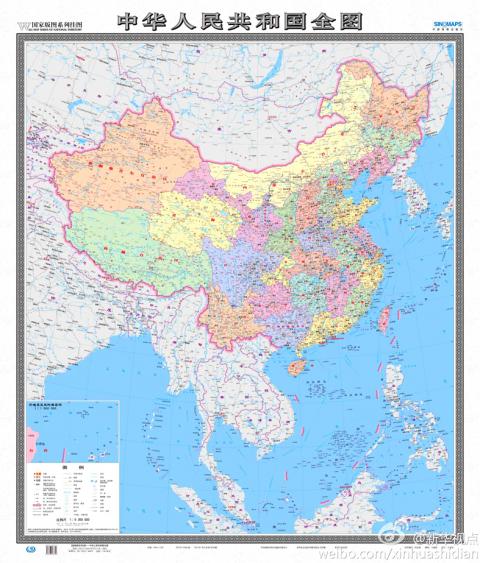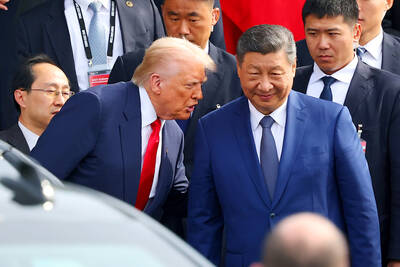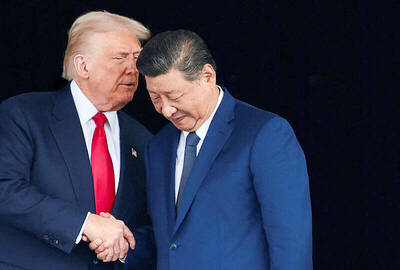A new map to be released later this month by China’s National Administration of Surveying, Mapping and Geoinformation increases from 29 to 130 the number of disputed areas marked as officially part of the People’s Republic of China (PRC), including the Diaoyutai Islands (釣魚台) claimed by Taiwan and Japan.
Previous editions of the “Wall Map Series of National Territory,” which presented China’s claimed territory in horizontal format, only included the larger contested islands in the South China Sea in a separate box at the bottom right of the map, Xinhua news agency said at the weekend. The territories included in the box were half scale and not clearly detailed.
The new map is vertical and is to be distributed by Sinomaps Press on behalf of the Chinese authorities starting next month. It will for the first time display the entirety of the PRC’s claimed territory on the same scale as continental China.

Photo from stcn.com
“The new map will be very significant in enhancing Chinese people’s awareness of national territory, safeguarding China’s marine rights and interests and manifesting China’s political diplomatic stance,” Xu Gencai (徐根才), editor-in-chief at Sinomaps Press, told Xinhua.
In all, the map includes 130 disputed areas, including Taiwan, islets and coral reefs in the Spratlys (Nansha Islands, 南沙群島), the Paracels (Xisha Islands, 西沙群島), the Pratas (Dongshan Islands, 東沙群島), the Macclesfield Bank (Zhongsha Islands, 中沙群島) and the Scarborough Shoal (Huangyan Island (黃岩島), which are the object of disputes between Taiwan, China, the Philippines, Vietnam, Brunei and Malaysia. It also includes the Diaoyutais, in the East China Sea.
In another first, an inset shows the northern tip of Taiwan and detailed mapping of the eight major islets comprising the Diaoyutais, known as the Senkakus by Japan.
Tensions in the area escalated last week, with China and Japan dispatching fighter aircraft after Chinese aircraft penetrated Japan’s Air Defense Identification Zone near the islets on three occasions.
Lu Chang-shui (盧長水), head of the Mainland Affairs Council’s Department of Information and Liaison, said the map was different from the one in new Chinese passports showing Taiwan and the South China Sea as Chinese territory, as well as pictures of Taiwanese tourist spots.
“A passport represents national sovereignty and a map is for a country’s internal use,” Lu said. “Consequently, the council will use different approaches to deal with the map and the passport.”
Lu added that official maps published by the government include the PRC as part of Republic of China (ROC) territory, as dictated by the ROC Constitution.
In related developments, state broadcaster NHK reported yesterday that Japan would deploy two additional patrol ships at its regional coast guard headquarters responsible for territory that includes the Senkakus.
The 335-tonne Kurose and the 3,100-tonne Chikuzen, which comes equipped with a helicopter, will be deployed in August and October respectively, it said.
Meanwhile, during a meeting in Sydney on Sunday, Japanese Minister of Foreign Affairs Fumio Kishida and Australian Minister of Foreign Affairs Bob Carr told a press conference that the two countries had agreed to increase bilateral cooperation on security issues, Kyodo news agency reported yesterday.
Additionally, the Asahi Shimbun reported that Japanese Prime Minister Shinzo Abe would embark on a trip to Southeast Asia tomorrow — his first since assuming office last month — where he will seek to deepen cooperation with ASEAN countries on trade, energy and security matters.
Additional reporting by Shih Hsiu-chuan and AFP

CALL FOR SUPPORT: President William Lai called on lawmakers across party lines to ensure the livelihood of Taiwanese and that national security is protected President William Lai (賴清德) yesterday called for bipartisan support for Taiwan’s investment in self-defense capabilities at the christening and launch of two coast guard vessels at CSBC Corp, Taiwan’s (台灣國際造船) shipyard in Kaohsiung. The Taipei (台北) is the fourth and final ship of the Chiayi-class offshore patrol vessels, and the Siraya (西拉雅) is the Coast Guard Administration’s (CGA) first-ever ocean patrol vessel, the government said. The Taipei is the fourth and final ship of the Chiayi-class offshore patrol vessels with a displacement of about 4,000 tonnes, Lai said. This ship class was ordered as a result of former president Tsai Ing-wen’s (蔡英文) 2018

UKRAINE, NVIDIA: The US leader said the subject of Russia’s war had come up ‘very strongly,’ while Jenson Huang was hoping that the conversation was good Chinese President Xi Jinping (習近平) and US President Donald Trump had differing takes following their meeting in Busan, South Korea, yesterday. Xi said that the two sides should complete follow-up work as soon as possible to deliver tangible results that would provide “peace of mind” to China, the US and the rest of the world, while Trump hailed the “great success” of the talks. The two discussed trade, including a deal to reduce tariffs slapped on China for its role in the fentanyl trade, as well as cooperation in ending the war in Ukraine, among other issues, but they did not mention

HOTEL HIRING: An official said that hoteliers could begin hiring migrant workers next year, but must adhere to a rule requiring a NT$2,000 salary hike for Taiwanese The government is to allow the hospitality industry to recruit mid-level migrant workers for housekeeping and three other lines of work after the Executive Yuan yesterday approved a proposal by the Ministry of Labor. A shortage of workers at hotels and accommodation facilities was discussed at a meeting of the legislature’s Transportation Committee. A 2023 survey conducted by the Tourism Administration found that Taiwan’s lodging industry was short of about 6,600 housekeeping and cleaning workers, the agency said in a report to the committee. The shortage of workers in the industry is being studied, the report said. Hotel and Lodging Division Deputy Director Cheng

‘SECRETS’: While saying China would not attack during his presidency, Donald Trump declined to say how Washington would respond if Beijing were to take military action US President Donald Trump said that China would not take military action against Taiwan while he is president, as the Chinese leaders “know the consequences.” Trump made the statement during an interview on CBS’ 60 Minutes program that aired on Sunday, a few days after his meeting with Chinese President Xi Jinping (習近平) in South Korea. “He [Xi] has openly said, and his people have openly said at meetings, ‘we would never do anything while President Trump is president,’ because they know the consequences,” Trump said in the interview. However, he repeatedly declined to say exactly how Washington would respond in